Exam 2 Clinical
Piriformis Syndrome
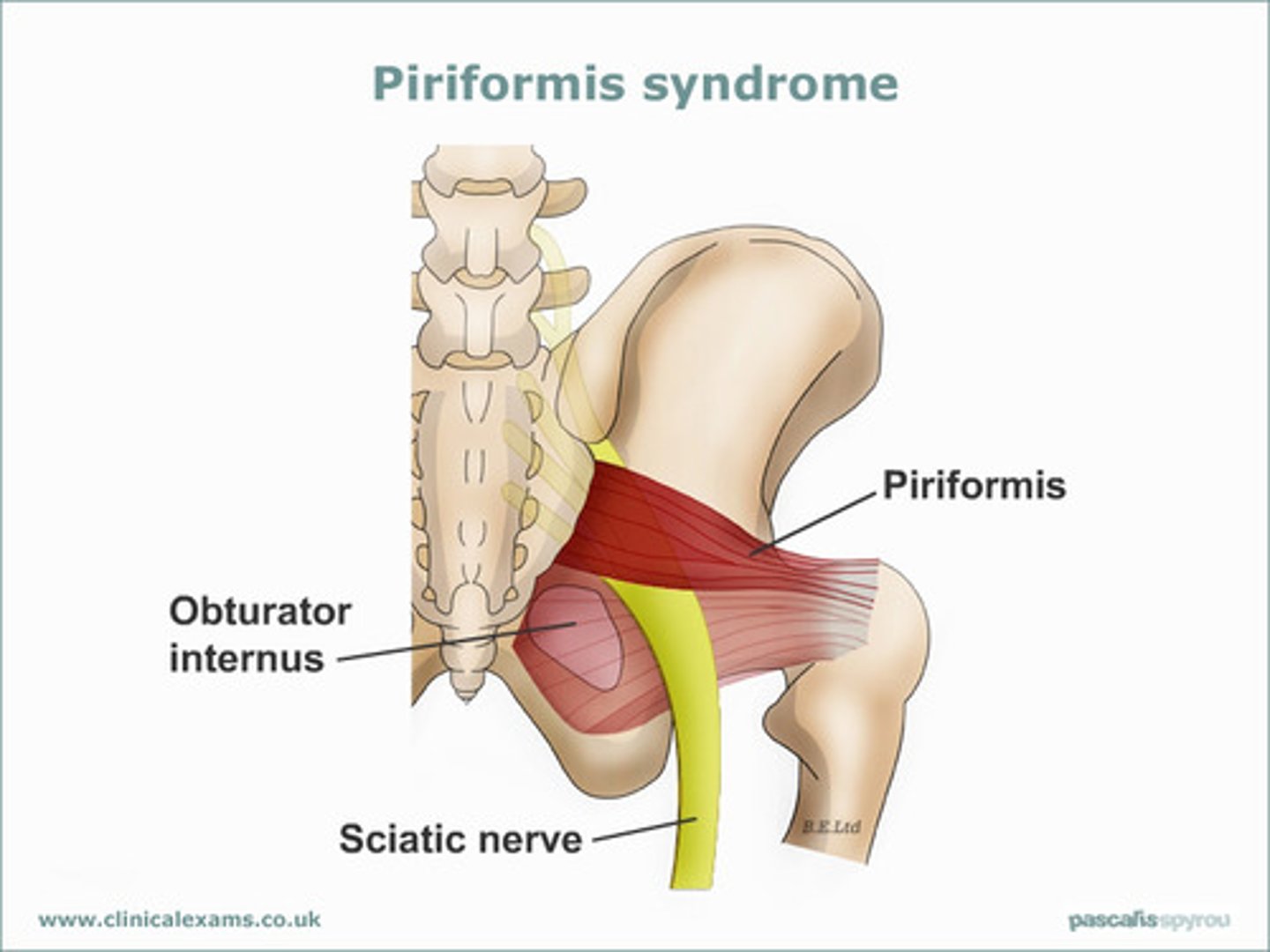
- tight piriformis muscle (resulting from repetitive contraction of gluteal muscles in sports like skating,cycling)
- may impinge on sciatic nerve, more common in anomalies where sciatic nerve penetrates piriformis muscle
- presents with pain in gluteal region; referred to groin, leg; intolerance to sitting
Tredelenburg's Sign
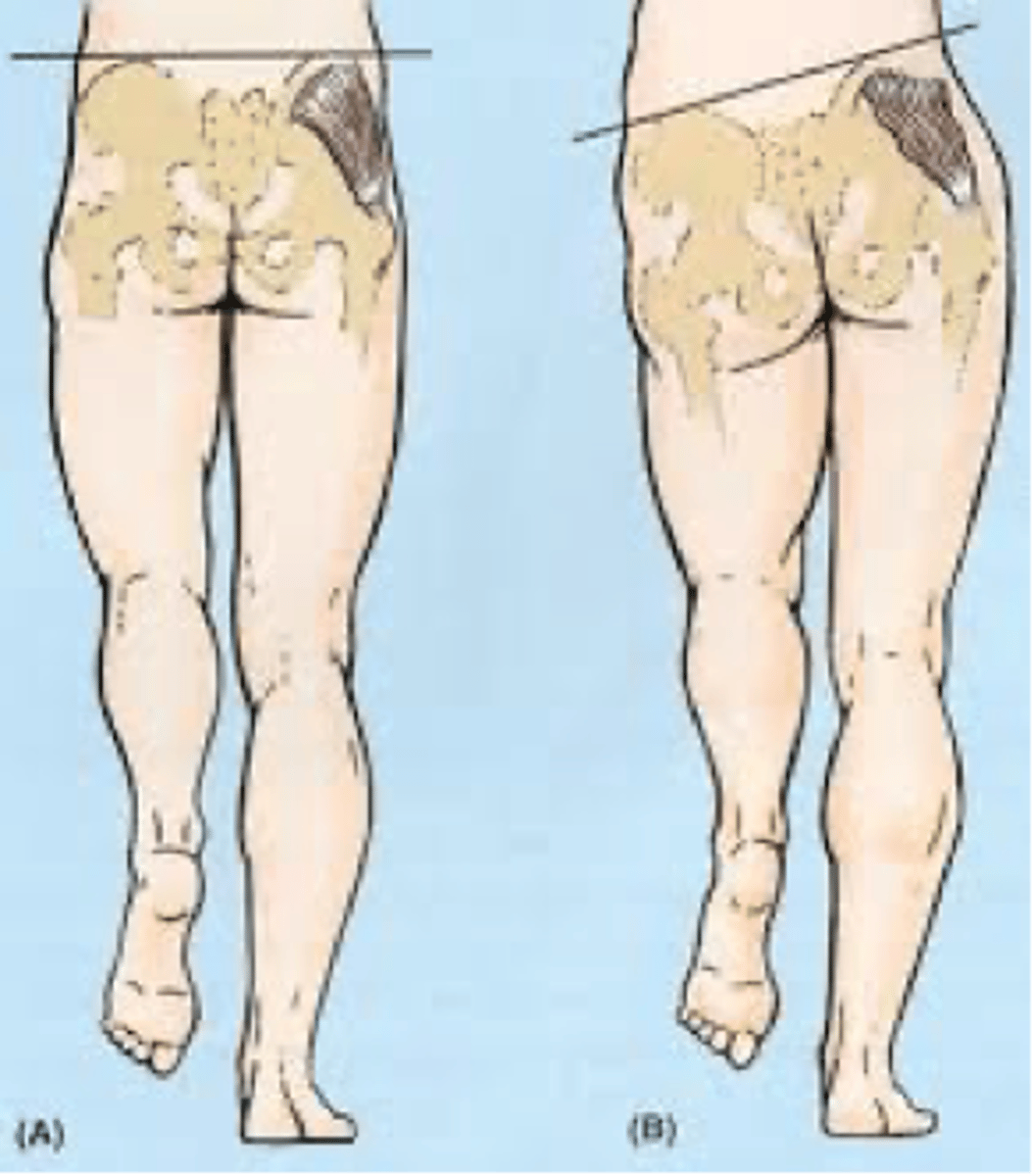
- swinging hip sags low during gait, suggesting problems with the contralateral gluteal region
- superior gluteal nerve is normally injured in a positive test
- weakness of gluteus medius/minimus,
- pelvis drops on the contralateral side of the stance leg
- loss of abduction of the hip
1/43
There's no tags or description
Looks like no tags are added yet.
Name | Mastery | Learn | Test | Matching | Spaced |
|---|
No study sessions yet.
44 Terms
Piriformis Syndrome
- tight piriformis muscle (resulting from repetitive contraction of gluteal muscles in sports like skating,cycling)
- may impinge on sciatic nerve, more common in anomalies where sciatic nerve penetrates piriformis muscle
- presents with pain in gluteal region; referred to groin, leg; intolerance to sitting

Tredelenburg's Sign
- swinging hip sags low during gait, suggesting problems with the contralateral gluteal region
- superior gluteal nerve is normally injured in a positive test
- weakness of gluteus medius/minimus,
- pelvis drops on the contralateral side of the stance leg
- loss of abduction of the hip

- non-necretizing inflammation of subcutaneous tissue
- may result in lymphadema
- inflammation at site of injury; red, swollen , warm but also present if there's a cut/scrap
celluitis
Lymphatic Drainage
Lateral leg
- follows small saphenous vein
- drain into popliteal lymphatics, up to deep inguinal lymph nodes
Medial leg, thigh group
- follows great saphenous vein
- drains into superficial subinguinal nodes inferior to saphenous opening, through saphenous opening into deep inguinal lymph nodes
Pelvis, perineum
- drain into superficial inguinal nodes superior to saphenous opening, through saphenous opening into deep inguinal lymph nodes
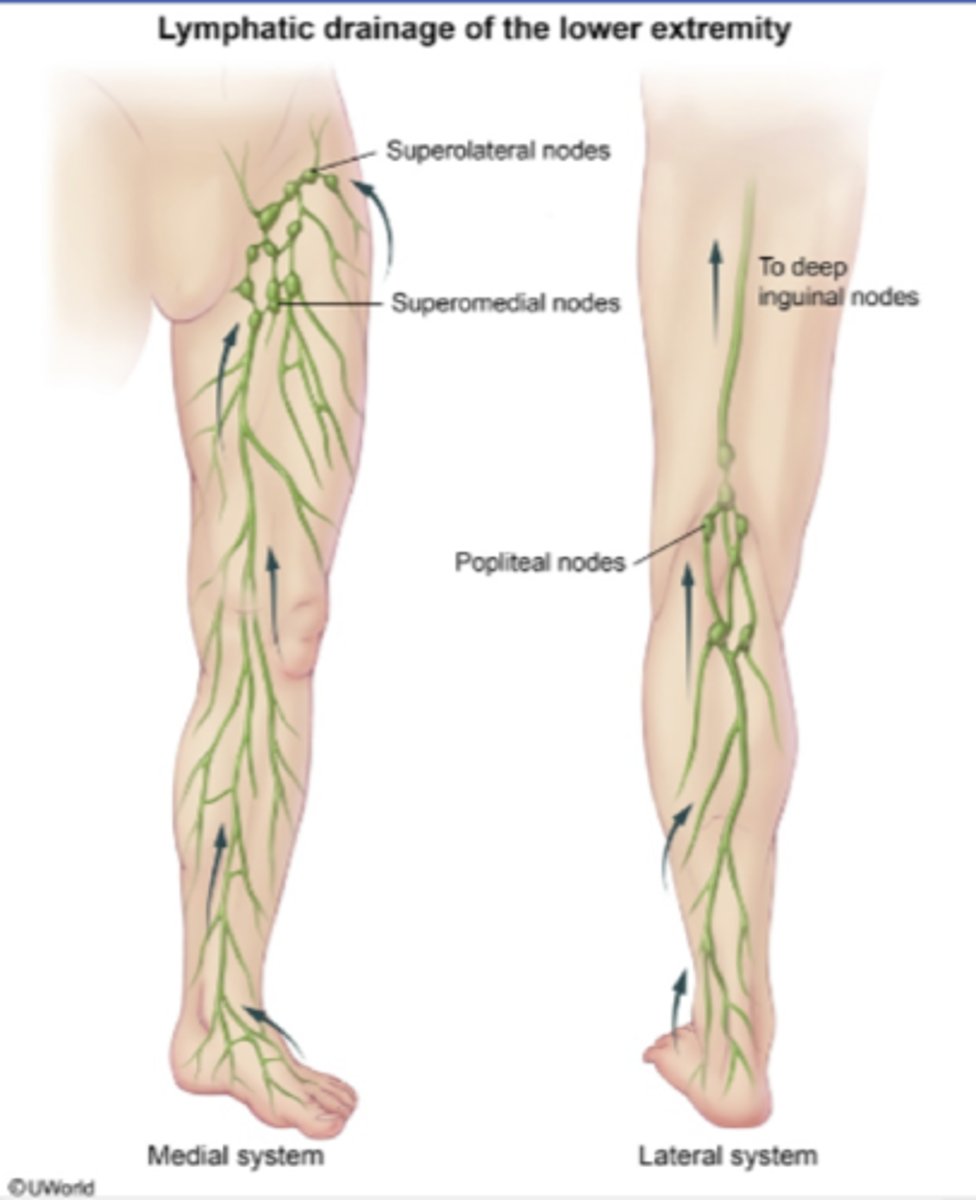
Meralgia Paresthetica
- lateral femoral cutaneous nerve becomes compressed can be caused from tight clothing, obesity, pregnancy, hip-hugging belts
- numbness/tingling presents in the lateral thigh
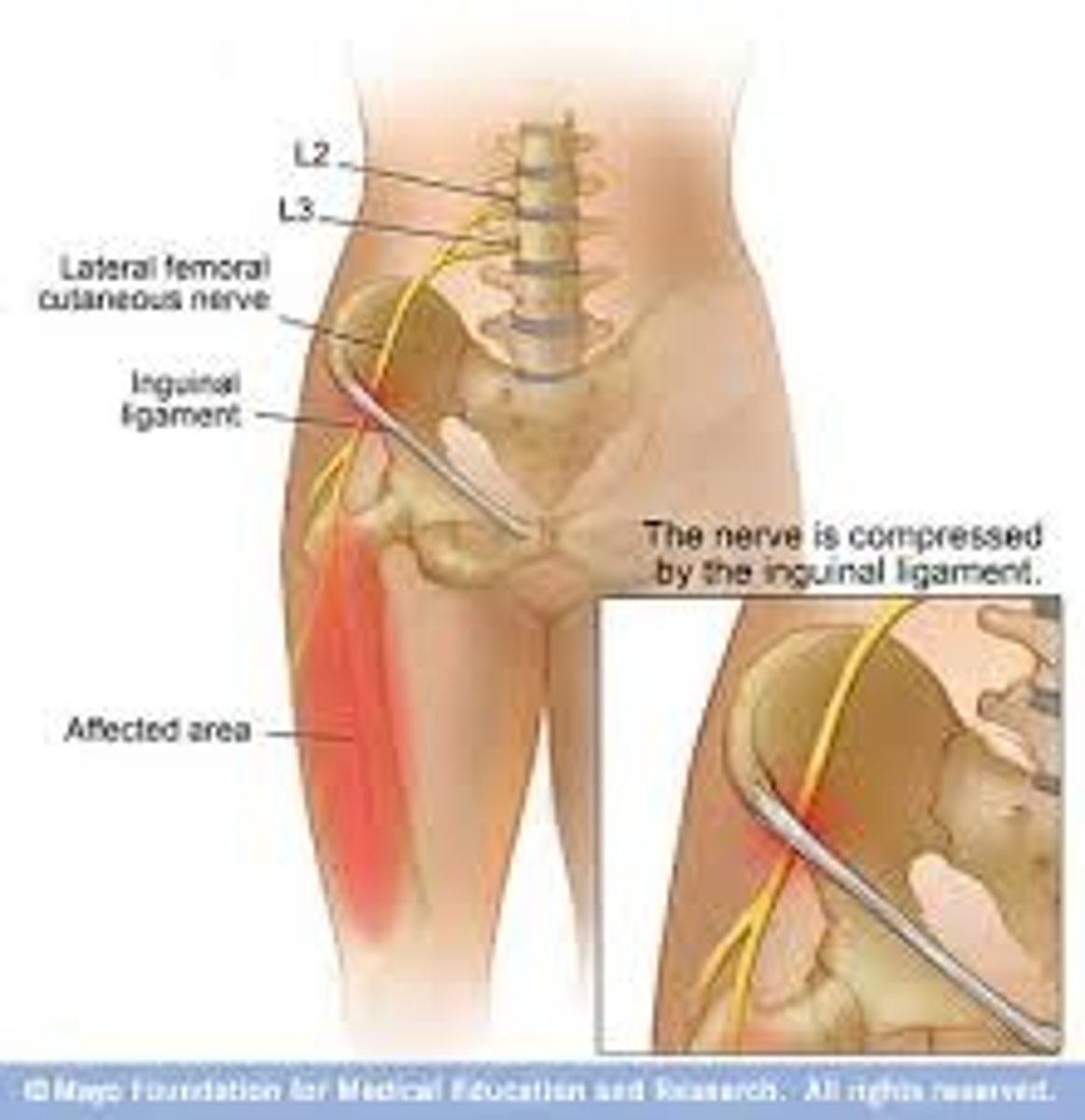
Groin Pulls
- tearing of hip adductors, results from excessive abduction, forceful adduction (eccentric contractions)
- typically at the origin off the ischiopubic ramus
Iliotibial Band/Patellofemoral Syndrome
- tightness of the ITB leading in the rubbing of the band at the hip and knee
- can be exaceberated with excessive q-angles
- also can result in lateral pull of the patella creating friction between the patella and lateral femoral condyle
- can lead to pain and inflammation, can worse with prolonged periods of knee flexion or "theater sign" - prolonged sitting
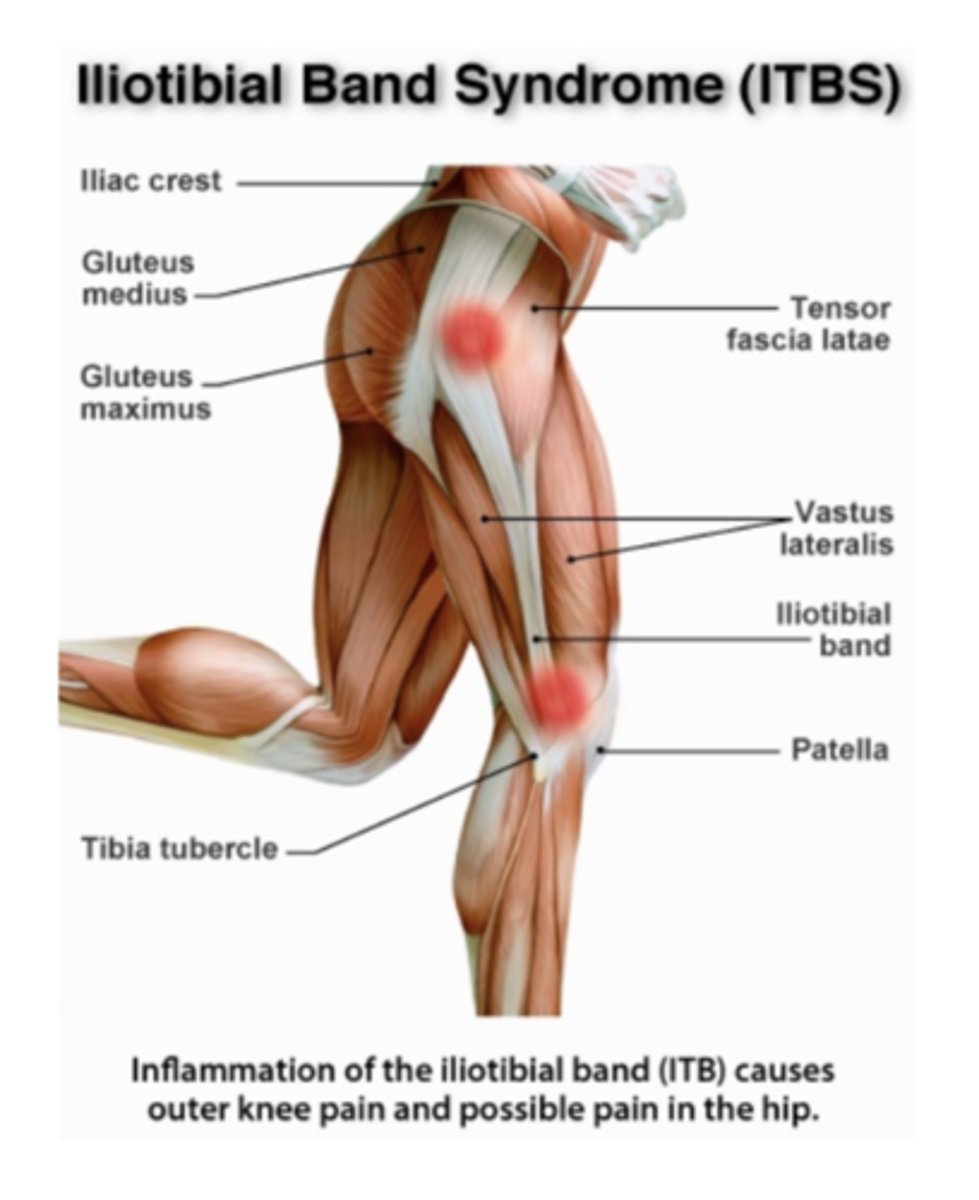
Iliopsoas Tendonitis
- inflammation of the iliopsoas tendon, often due to overuse, especially hip flexion activities (ex. running)
- hip flexion is primarily affected
- pain can be reproduce when using the resisted straight leg raise or the Thomas test
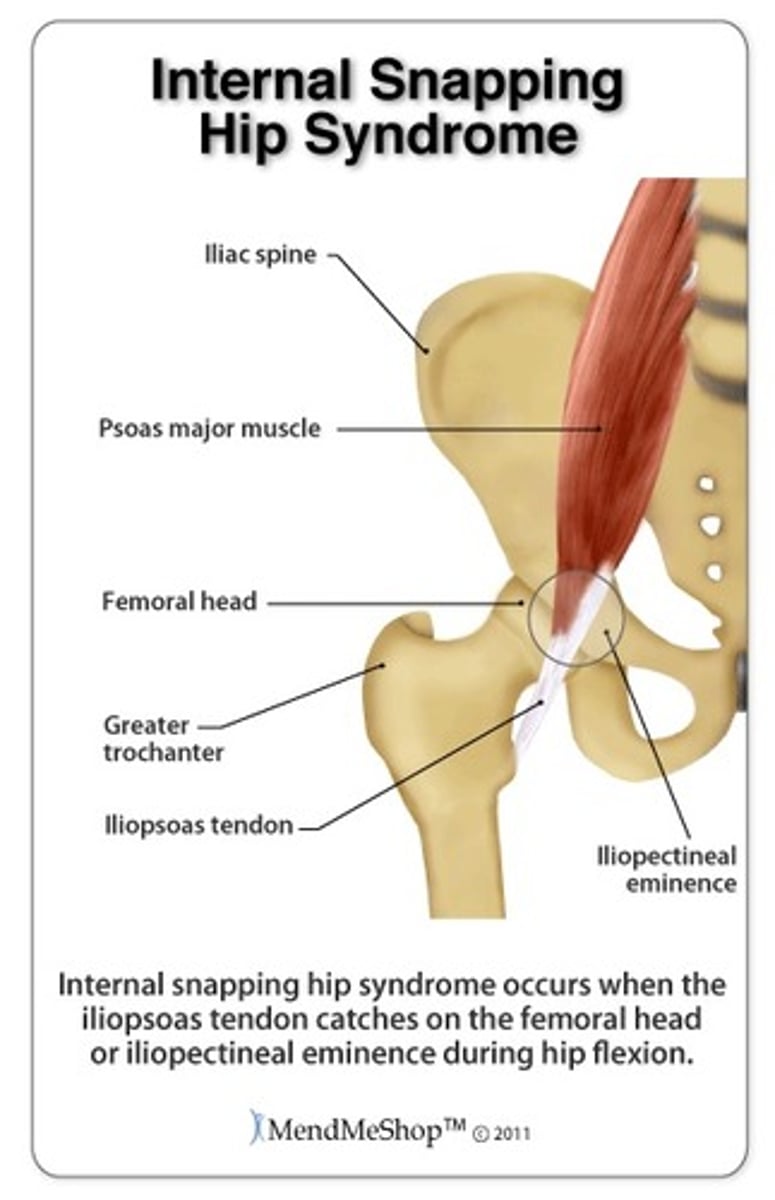
Iliopsoas Bursitis
- inflammation of the iliopsoas bursa causing anterior hip/groin pain
- caused by repetitive hip flexion (sports, poor posture, leg length discrepancy,)

Snapping Hip Syndrome
- condition results in an audible snapping or clicking sound with specific movements
External
- gluteus maximus, tight ITB
Internal
- iliopsoas tendon
- can be related to hip joint pathologies but they are less commmon
- the snapping and clicking can also be seen in Iliopsoas tendinitis/bursitis when the tendon is catches on the pectineal line
Deep Vein Thrombosis
- due to clotting of stagnant blood in deep veins
- caused from prolonged sedentary position like sitting for long flights or being bed ridden
- commonly seen in hospital setting
- venous clots may break off and reach the lung resulting in life threatening pulmonary embolism
Prepatellar Bursitis
- inflammation of bursa between skin and patella
- presents with pain, swelling, redness in knee, difficulty moving
- also can be seen if one has a history of reptive motion, chronic kneeling or falls
- also known as "housemaids knee"
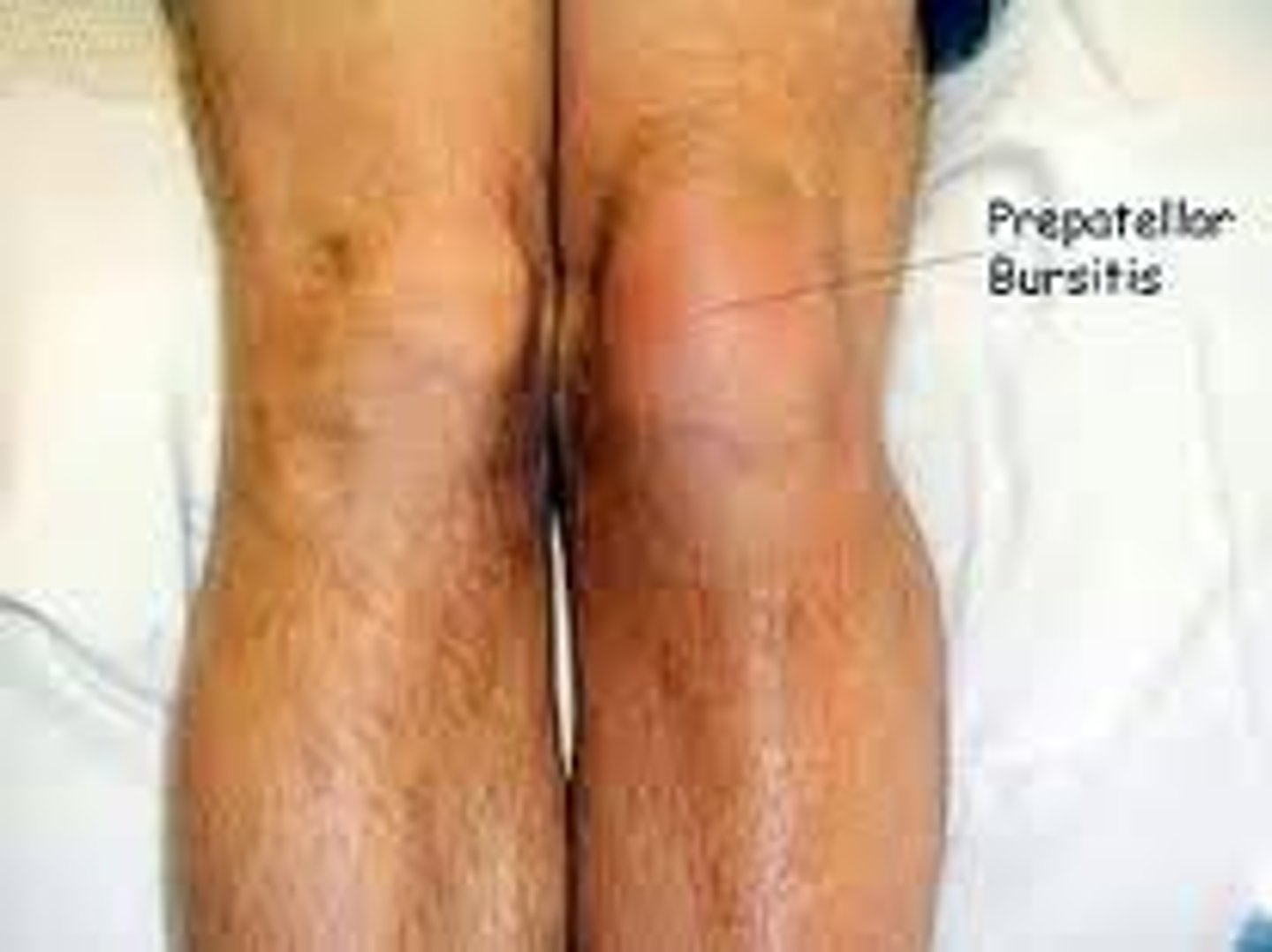
Infrapatellar Bursitis
- also known as "clergyman's knee"
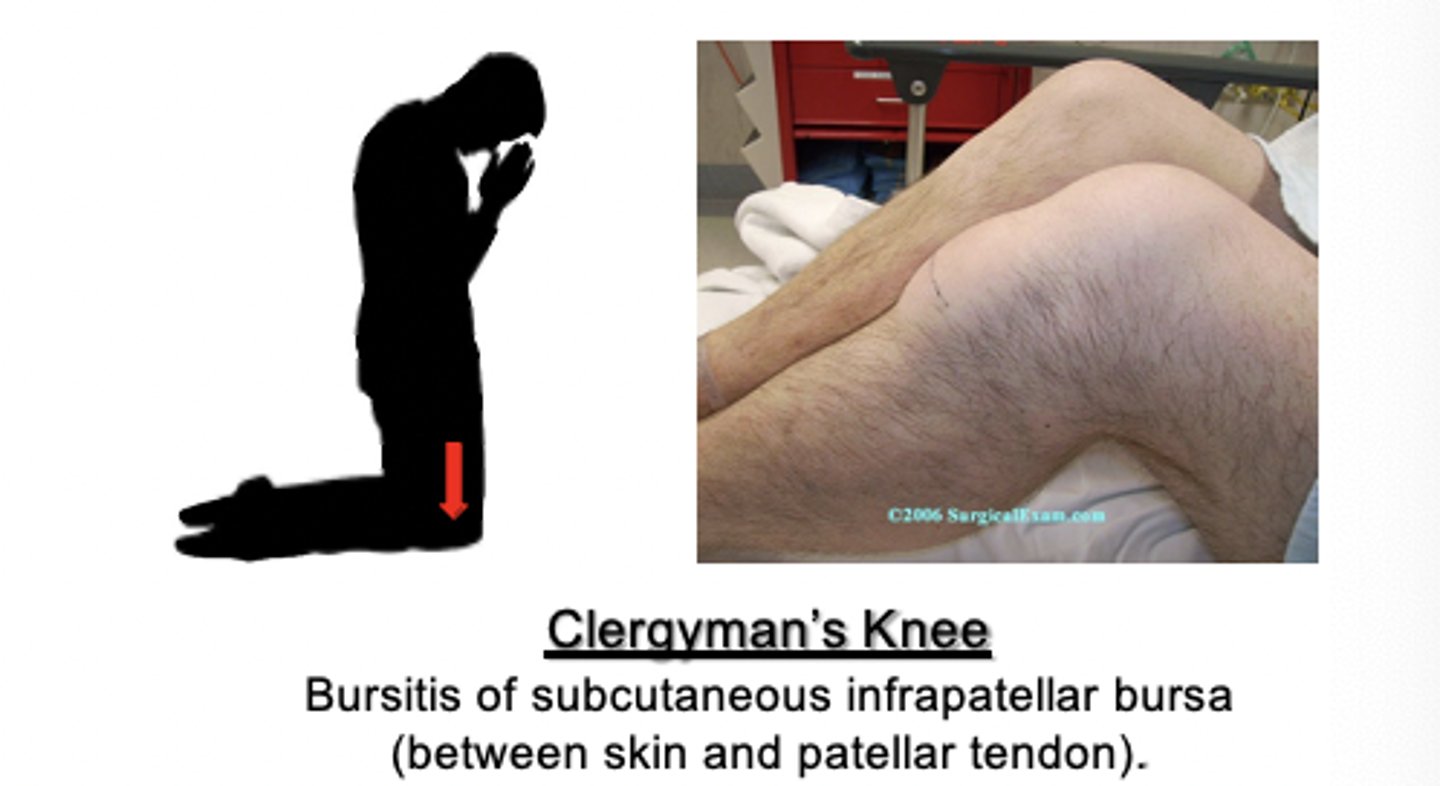
Popliteus Tenditis
- inflammation of the popliteal attachment most commonly to tibia
- presents with knee flexion pain from full extension or running down hill
Achilles Tendon Rupture
- complete tearing of the triceps surae tendon
- presents with sudden snap with acute pain, inability to stand on the affected side
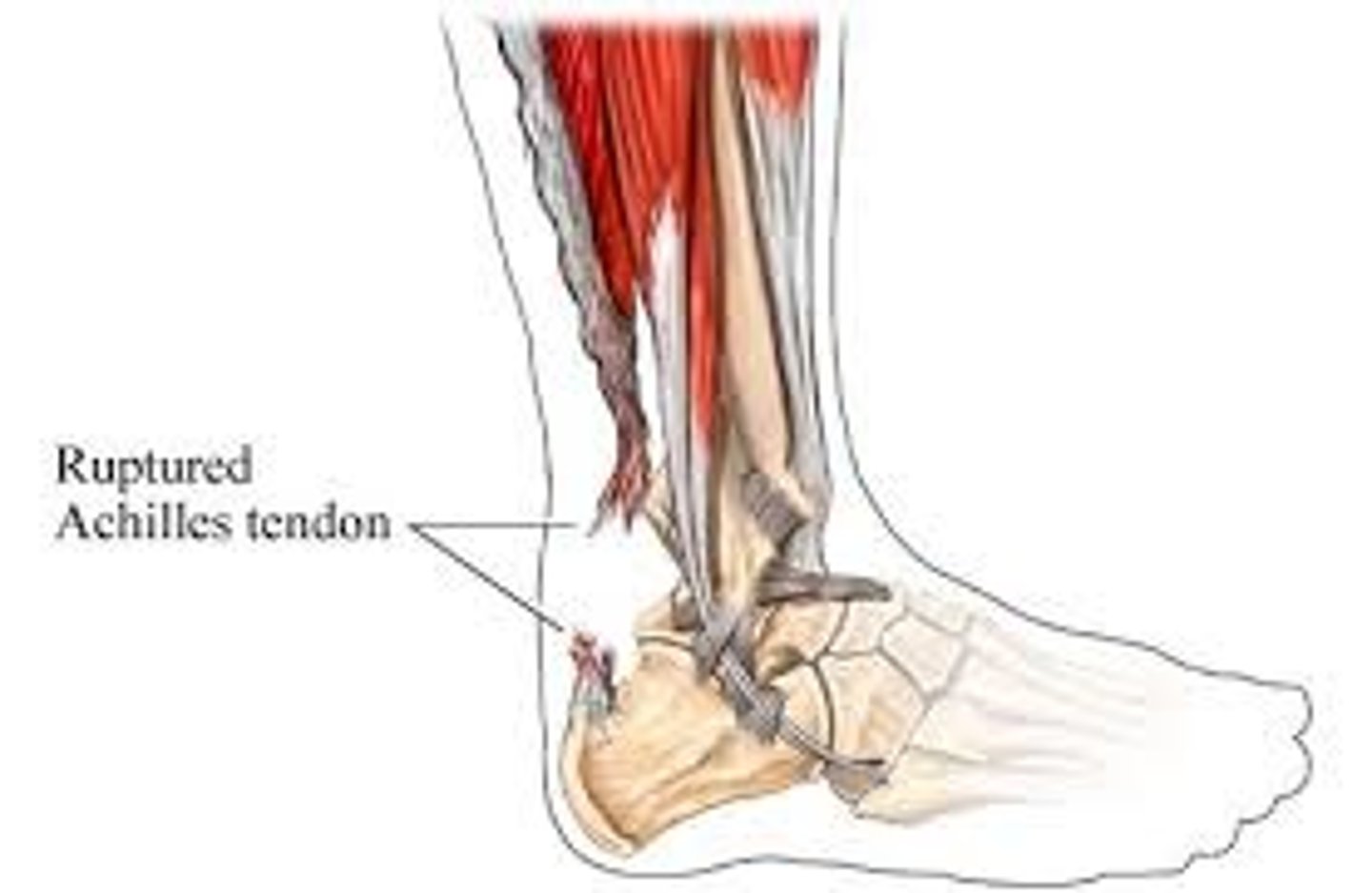
Avulsion Fracture
- also known as pseudo-Jones fracture , forceful contractions from the fibularis brevis causes break in base of 5th metatarsal
- presents with avoidance of push off phase and point tenderness at the base of the 5th metatarsal
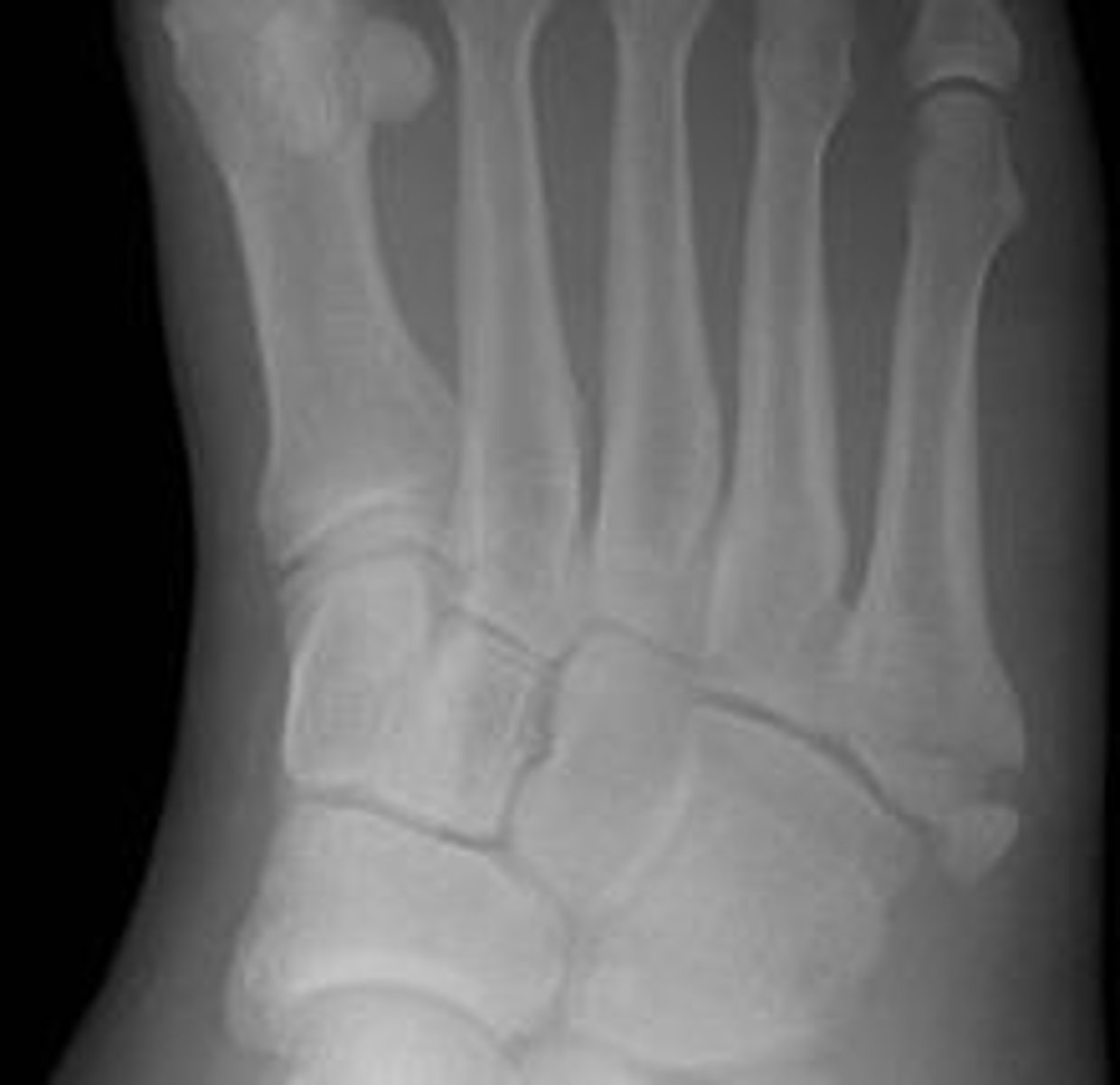
Shin Splints
- pain along the anterior aspect of the leg
- results from microtearing along the tibialis posterior attachment to the interosseus membrane from repetitive stresses
- presents with dull aching pain to front of the leg
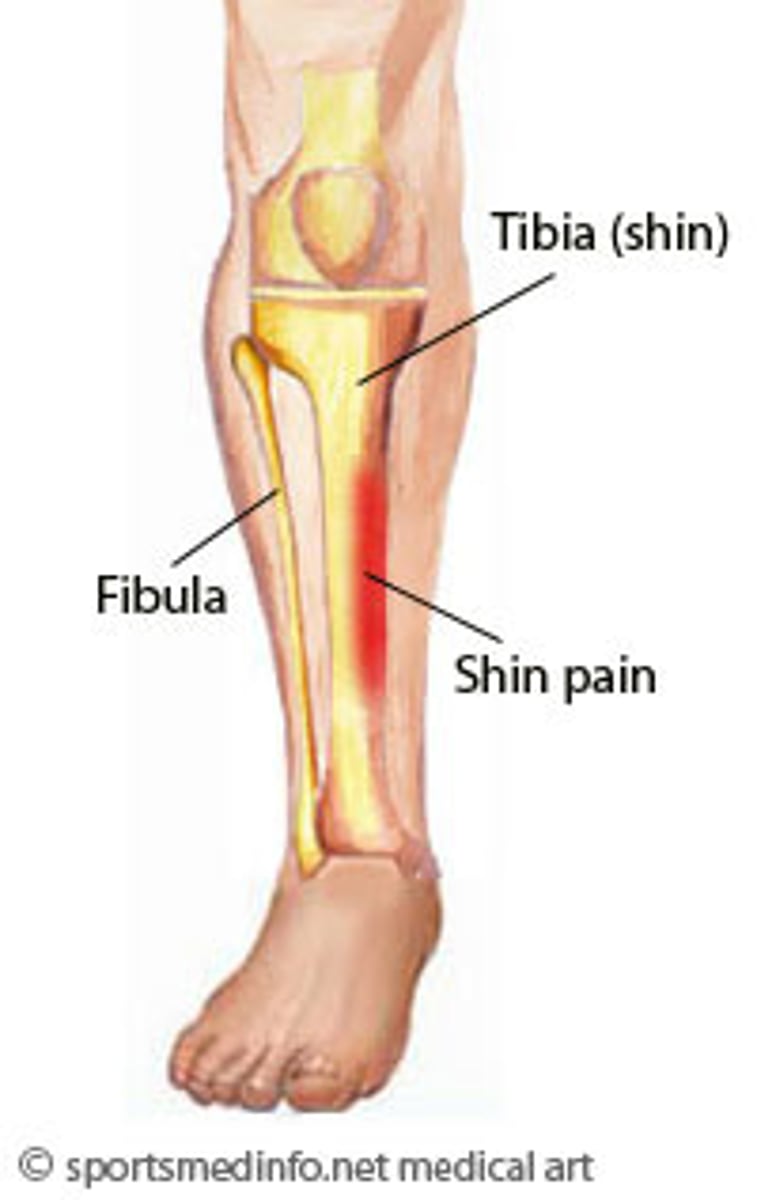
Anterior Compartment Syndrome
- gradual and progressive buildup of compartmental pressure, commonly seen in competitive athletes
- commonly seen in the lower legs
- presents with exercise induced pain; pain, tightness, cramping , dull ache
- loss of dorsiflexion strength, decreased dorsalis pedis pulse, capillary refill, numbness in webbing between great and second toe
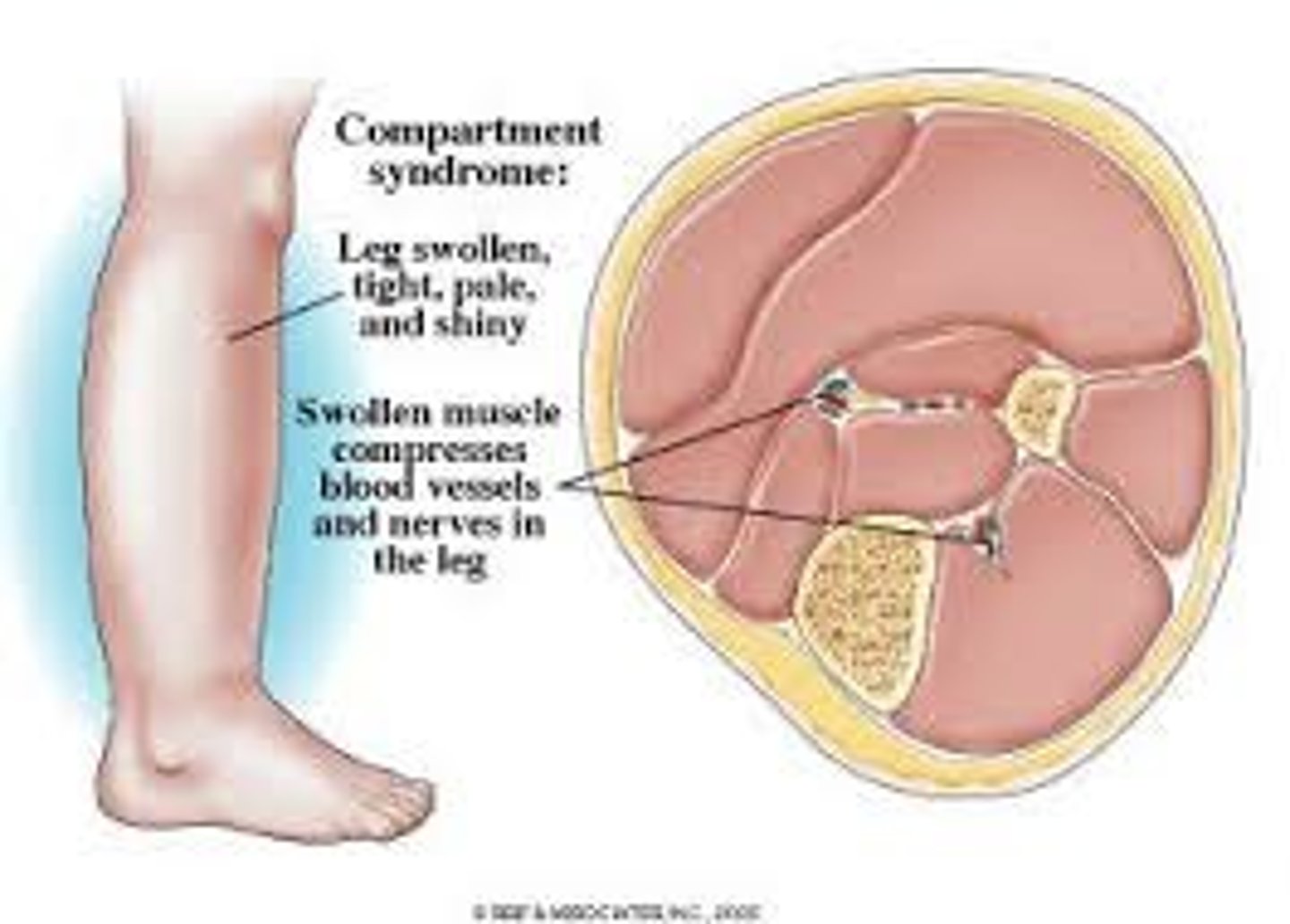
Common Fibular Neuropathy
- nerve lesion, typically due to direct trauma (compression/stretch injury)
- presents with frequent tripping, possible "foot drop" gait , pain at site of compression, parasthesia in lateral leg, foot
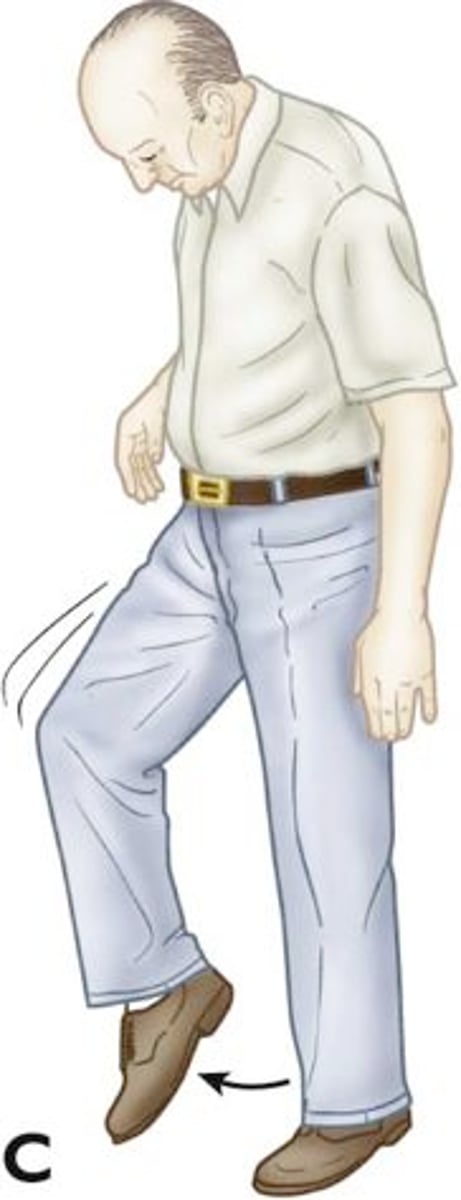
Neck of femur strain or fracture - why is it common and how does it present?
- common fracture site, especially in elderly with osteoporosis
- often caused by sudden hard impact (ex. falls)
- sometimes referred to as a "broken hip" (even being distal to the actual hip joint)
- orientation of the bone and muscle pull contributes to fracture risk
Which vein is commonly used in bypass graft surgery?
great saphenous vein
- commonly used in coronary artery bypass grafting
The gluteus maximus is a common site for?
- intramuscular injections
- know as "safe region" because it's found laterally and is in void of neurovascular structures
What is rickets syndrome?
- disease in children causing soft or weak bones
- caused by vitamin d defiency or lack of sun exposure
- presents with bone deformities such as bowed legs and a widened epiphyses due to stresses of weight bearing
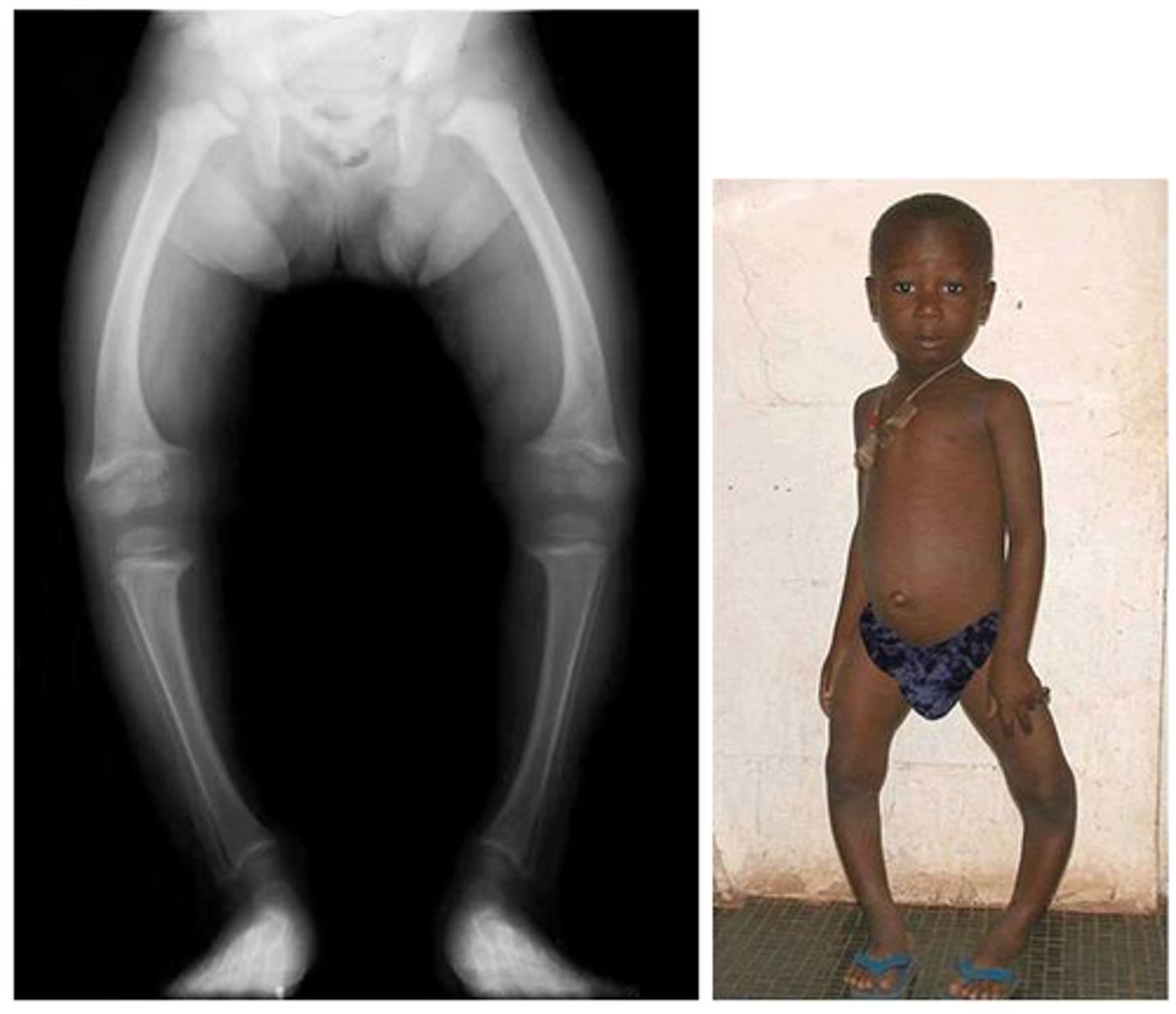
Is tibial nerve injury common or uncommon and why?
uncommon
- but would produce loss of plantar flexion; patient shows highly modified gait
- presents with extreme lateral rotation of hip to avoid unwanted dorsiflexion during stance phase
What is a Baker's cyst and where is it located?
- a fluid swelling in the popliteal fossa (behind the knee)
- caused from excess synovial fluid from the knee joint
- can present with tightness, swelling, or discomfort when extending the knee
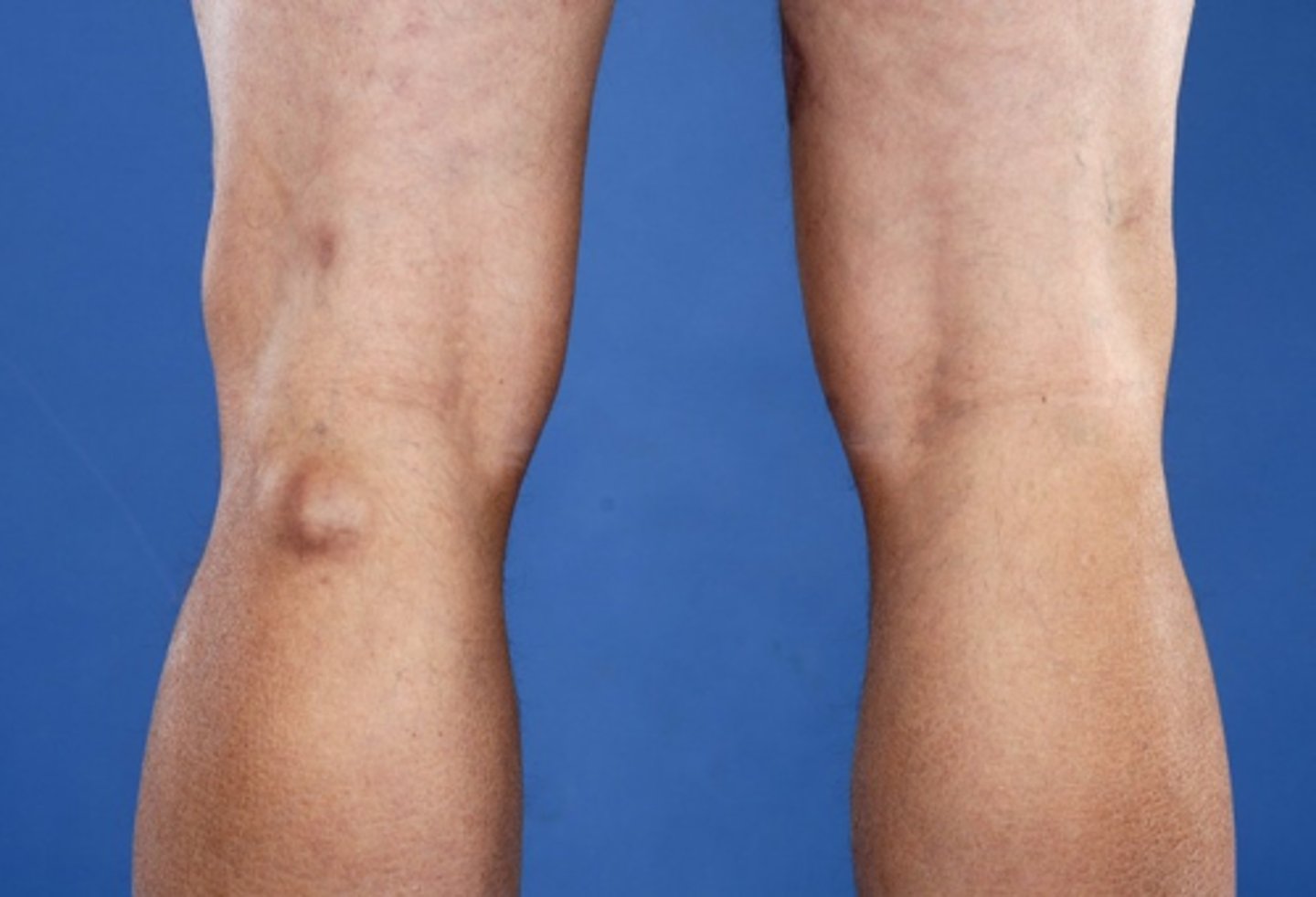
What is an ACL rupture and how does it present?
tear of the anterior cruciate ligament
- caused by sudden stops, changes in direction or twisting injuries directly seen in sports
- can present with symptoms like popping sound, knee instability, swelling , or pain
- positive anterior drawer test will confirm
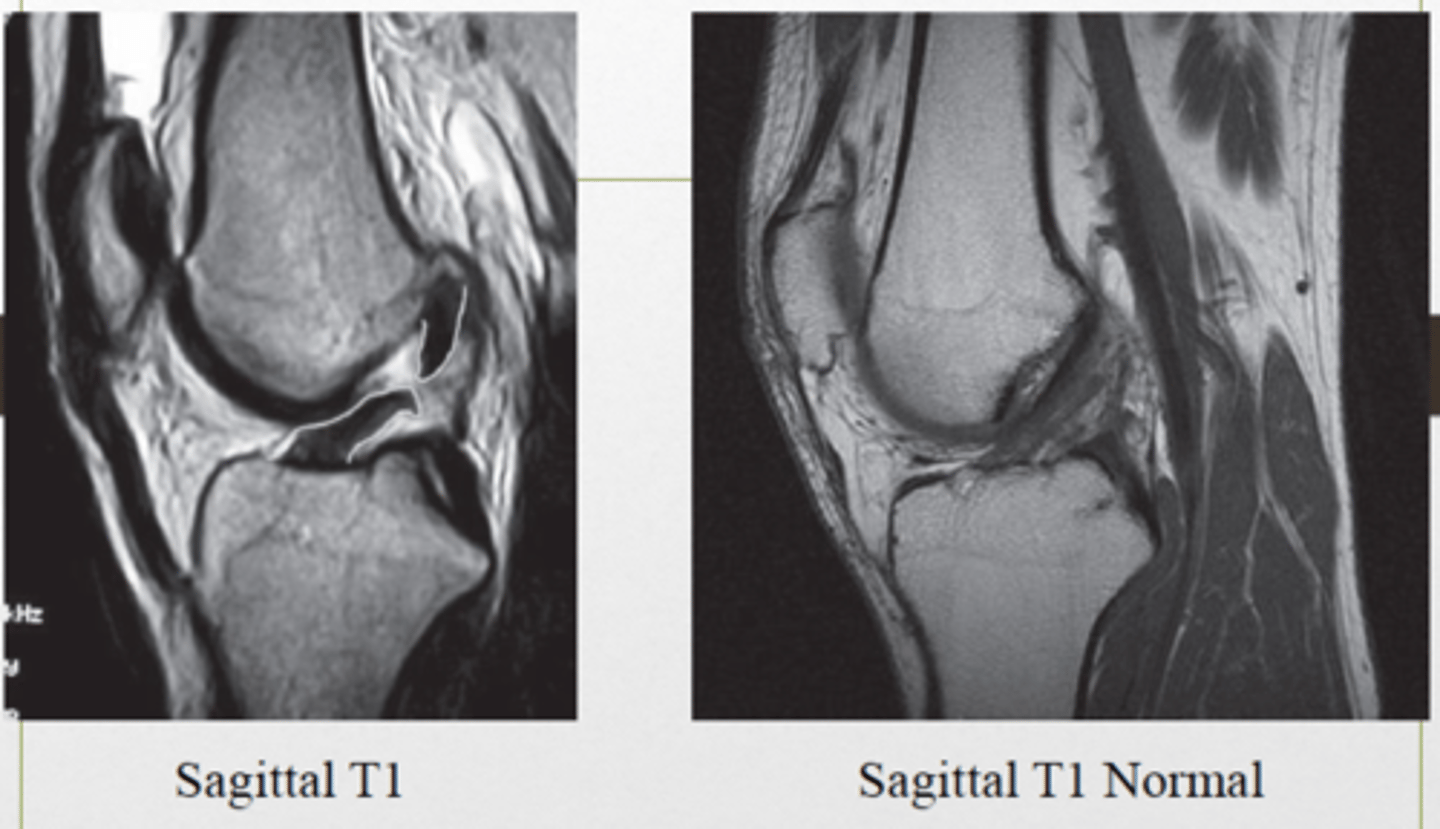
What is a PCL rupture and how does it occur?
tear of posterior cruciate ligament
- less common than ACL ruputre
- usually caused from a direct blow to the anterior tibia
- can present with posterior knee pain, mild swelling, instability with walking downhill or downstairs
Which meniscus is more commonly injured and why?
medial meniscus
- due to it being the less mobile because of it's attachment to the MCL and joint capsule
- often torn with valgus stress or ACL injuries
Which meniscus is less commonly injured and why?
Lateral meniscus
- more mobile than medial , not attached to the LCL
- injured by varus stresses or twisting traumas
- can occur with rotational force or isolated injuries
What is knee arthritis and how does it present?
a degenative joint disease causing breakdown of articular cartilage in the knee
- commonly seen in older adults, especially with previous joint overuse or injuries
- presents with pain with activity, stiffness (especially in the morning), limited range of motion, joint swelling
- will present in radiograph with joint space narrowing
What is a lateral ankle sprain?
resulting from posteromedial force causing rotation along Axis of Henke
- seen commonly when one quickly changes direction or speed from running forward
- anterior talofibular ligament is almost always involved in lateral ankle sprains
- presents with pain/swelling anterior-inferior to lateral malleolus
- also pain with palpitation and ankle inversion, anterior draw test is also an indicator
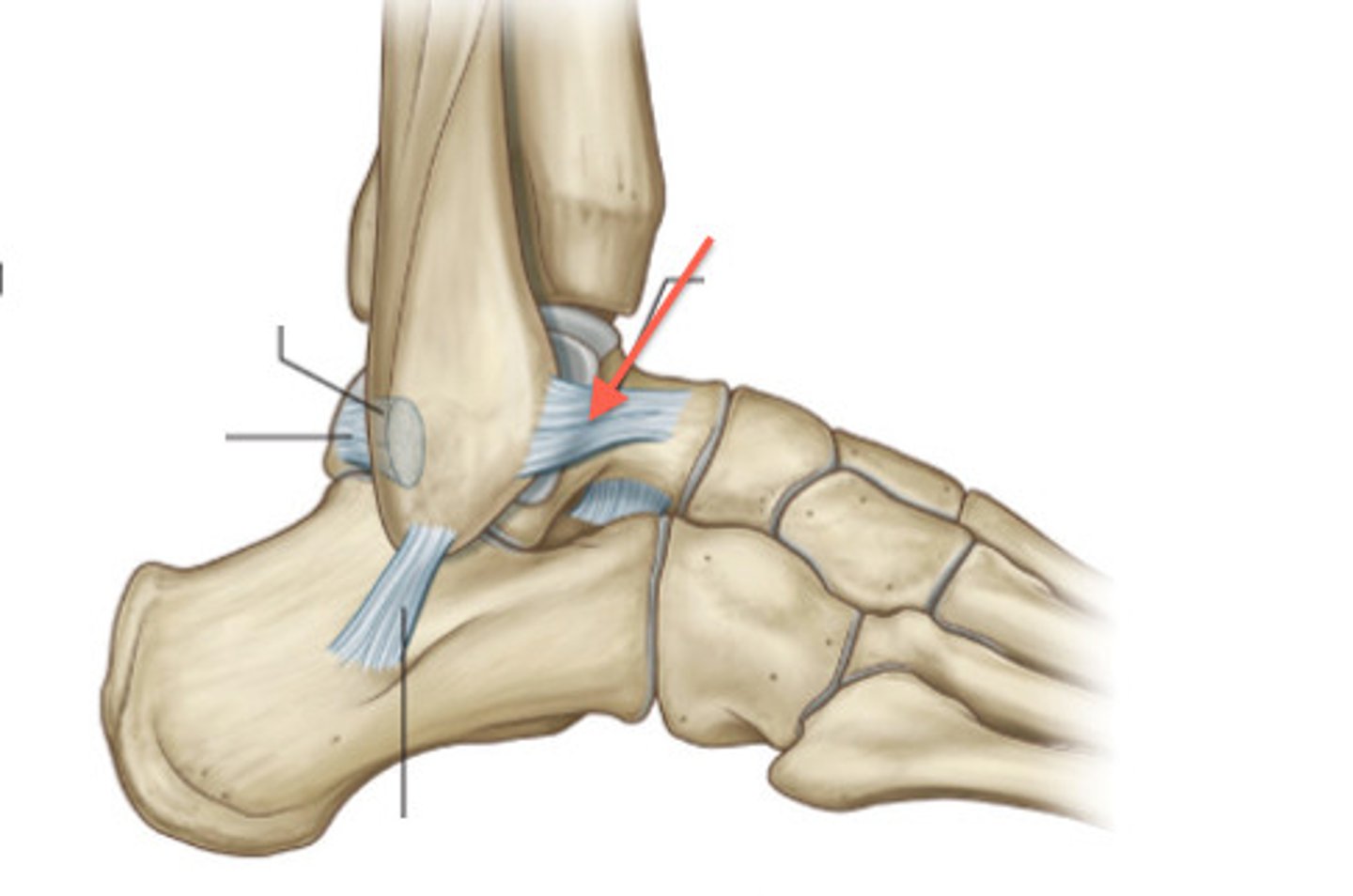
What is plantar fascitis?
irritation at the insertion of the plantar fascia on the calcaneal tuberosity
- resulting from microtrauma to the plantar fascia (poor fitting shoes, improper gait)
- presents with intense sharp pain at calcaneal tuberosity with first couple steps in the morning and after long periods of non-weight bearing
- pain will decrease with initiation of movement
- palpation is painful with passive extension of digits
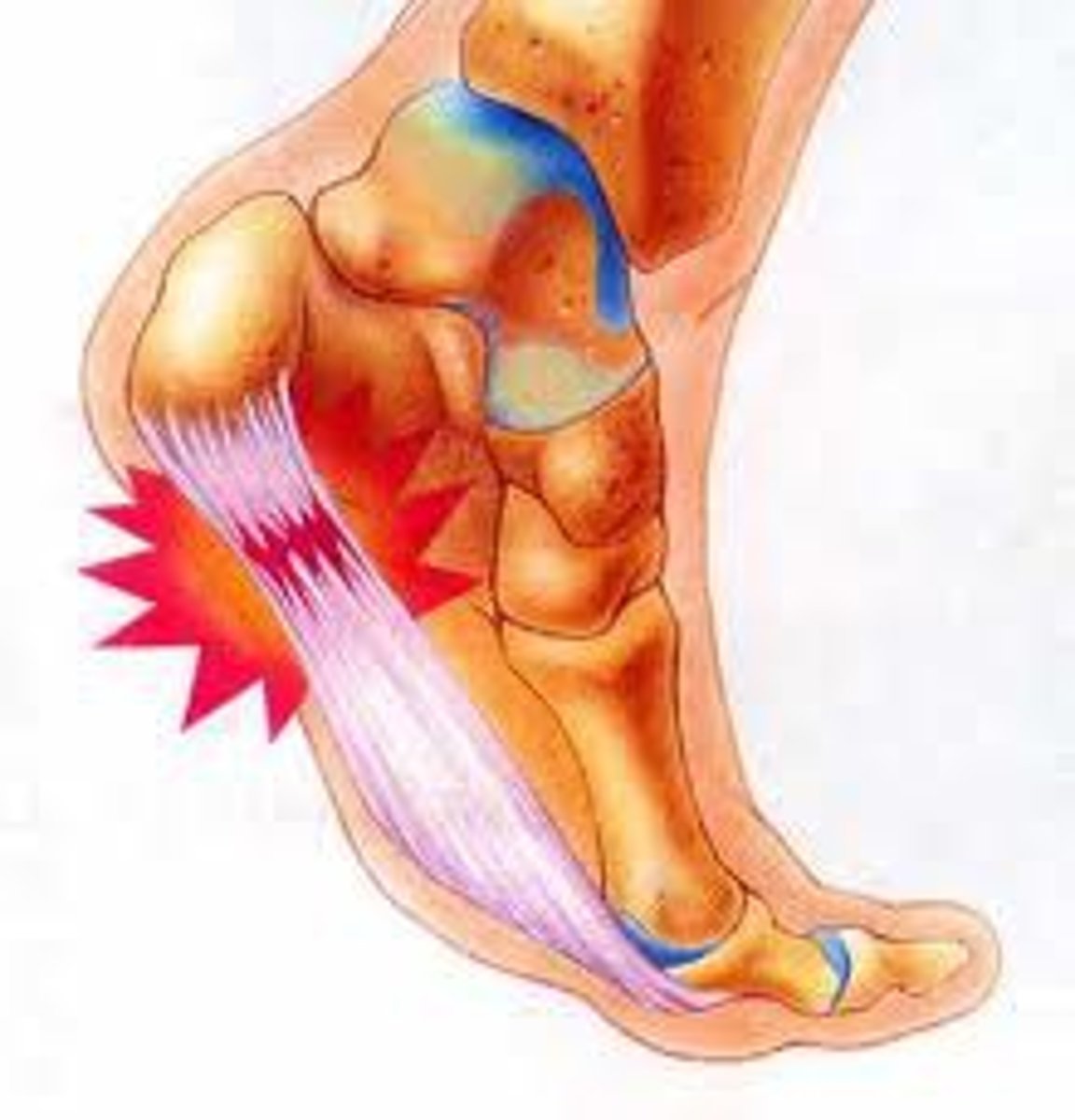
what is a syndesmotic (high) ankle sprain?
a distal tibiofibular joint sprain
- presents with pain in outside-front of the leg above ankle, pain with applied rotational force with minimal swelling
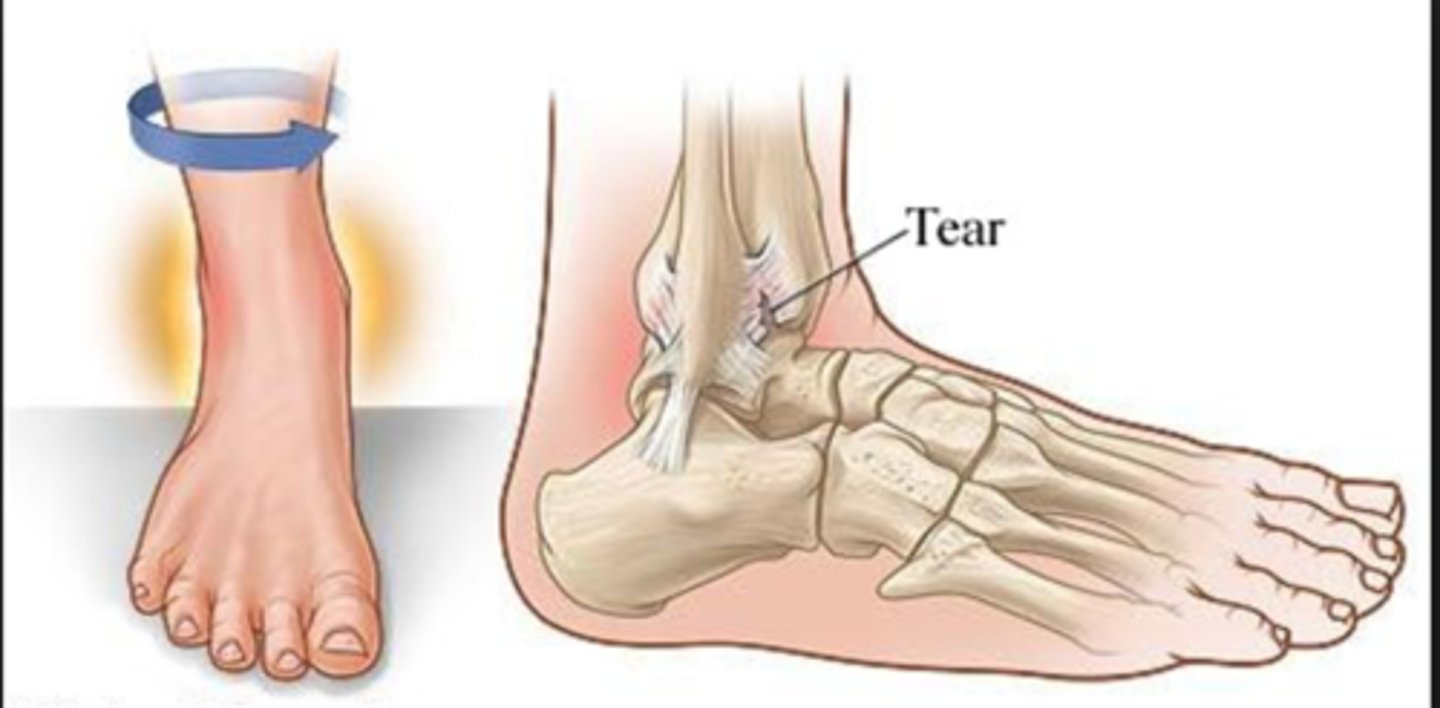
What is seen in an ankle fracture with dislocation?
typically seen with torsional force on the ankle
- twisting of the talus leads it malleolar fractures and dislocation of the talus away from subtalar joint
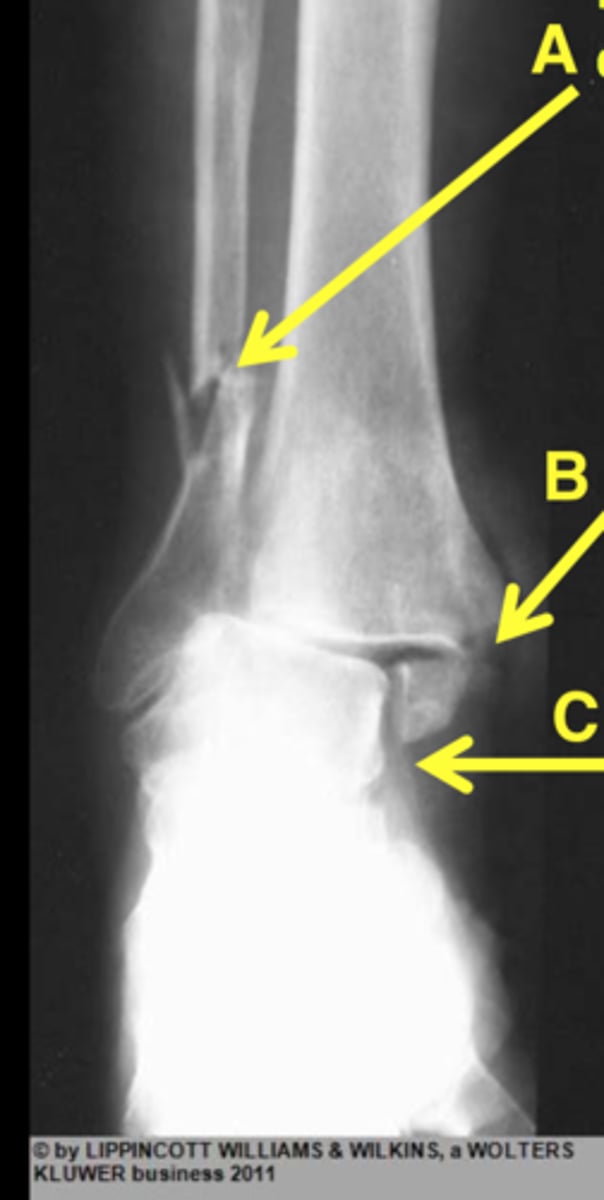
What is a "Ski Boot" fracture?
form of high boot top fracture
- fracture will typically occur at the point where top of shoe/boot ends
- fracture pattern seen in sports like hockey and skiing
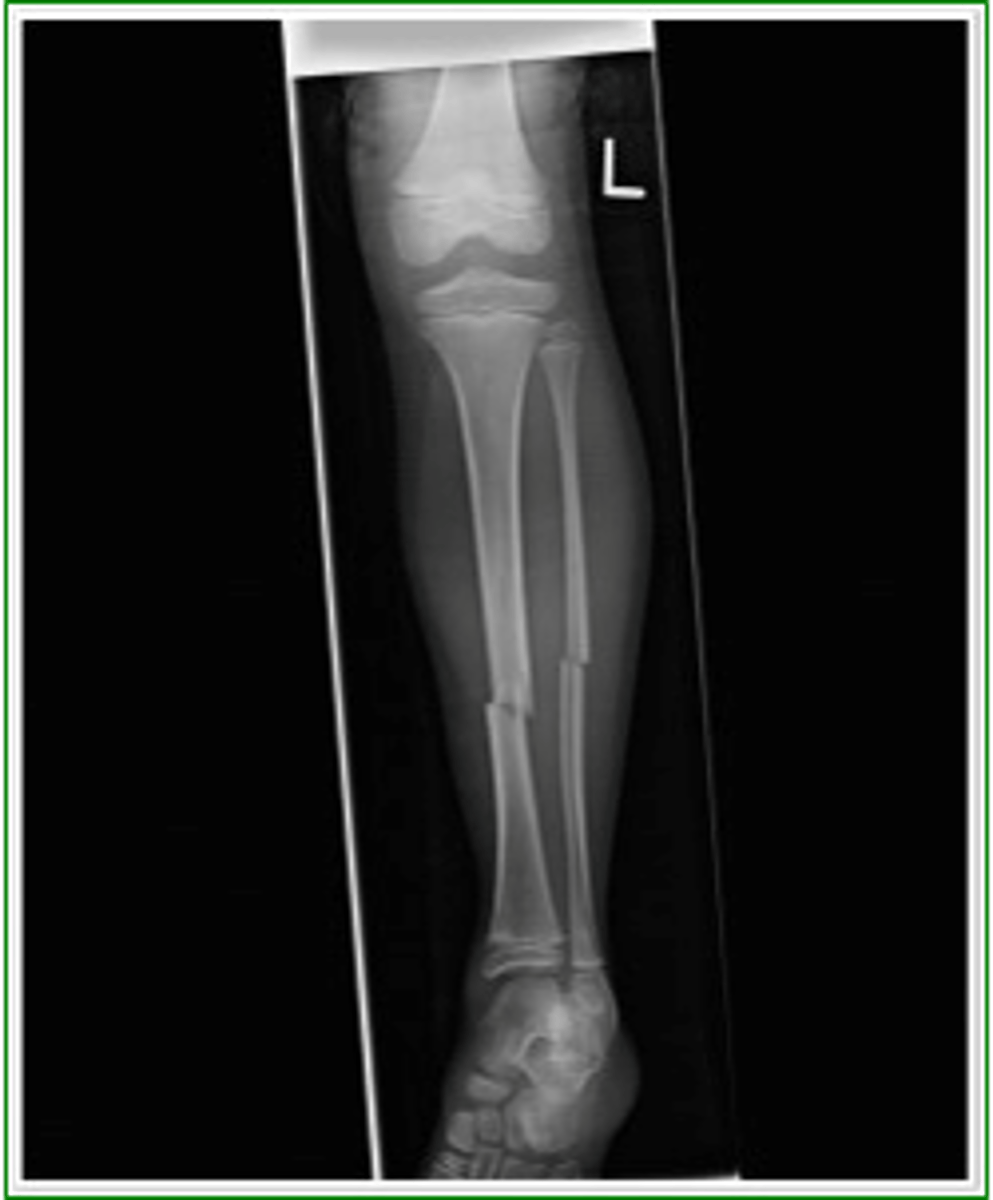
What is Ely's test and what does it indicate?
ely's test assess rectus femoris tightness
- the patient will lay prone and while the patients knee is being flexed
- a positive test occurs if the hip on the same side spontaneously lifts off the table indicating a tight rectus femoris muscle
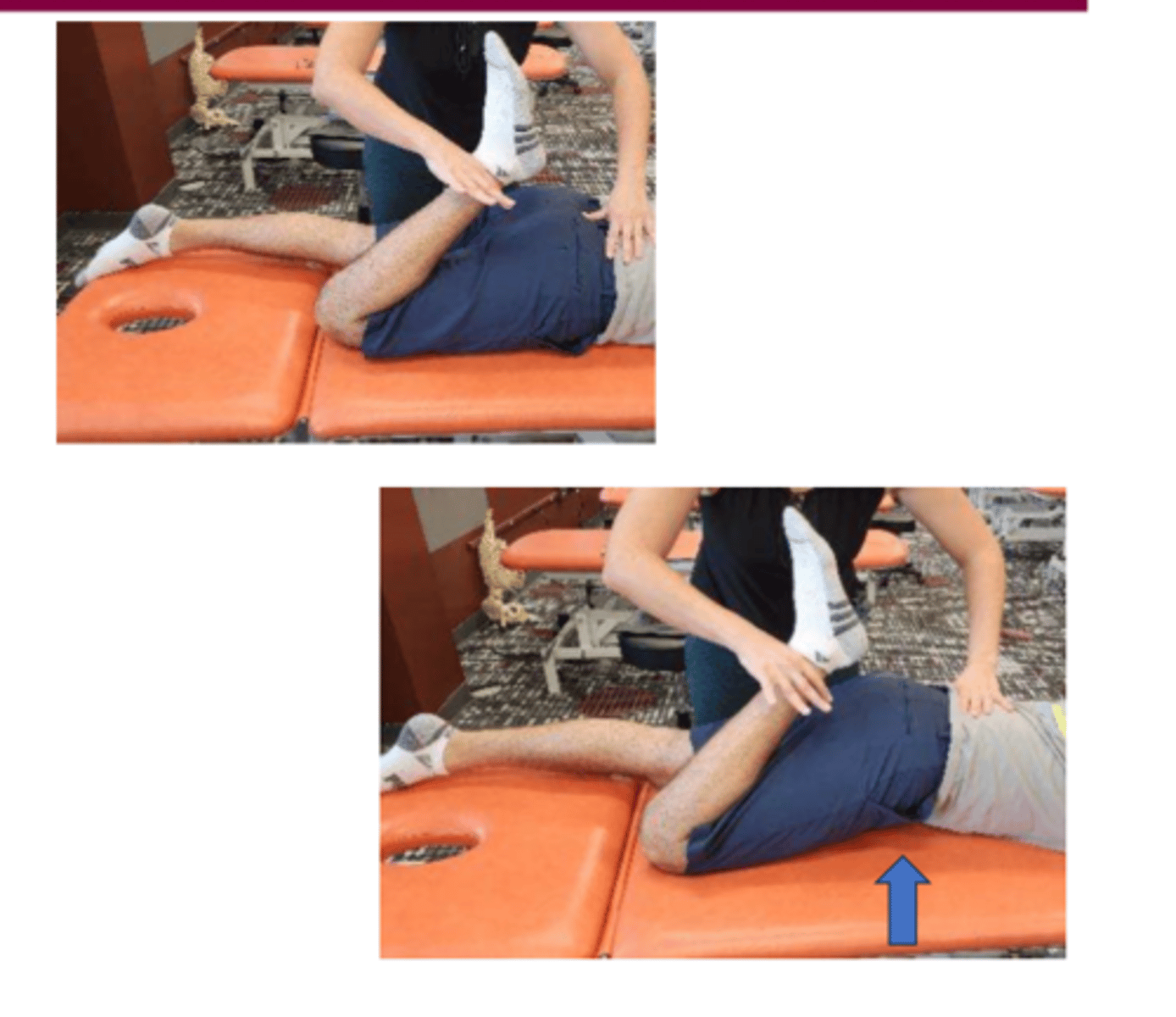
What is the tibial (medial) collateral ligament (MCL) and what is its function?
MCL connects the medial femur to the medial tibia
- it resists valgus stresses, stresses pushing the knee inwards
- stabilizes the medial side of the knee, more commonly
injured
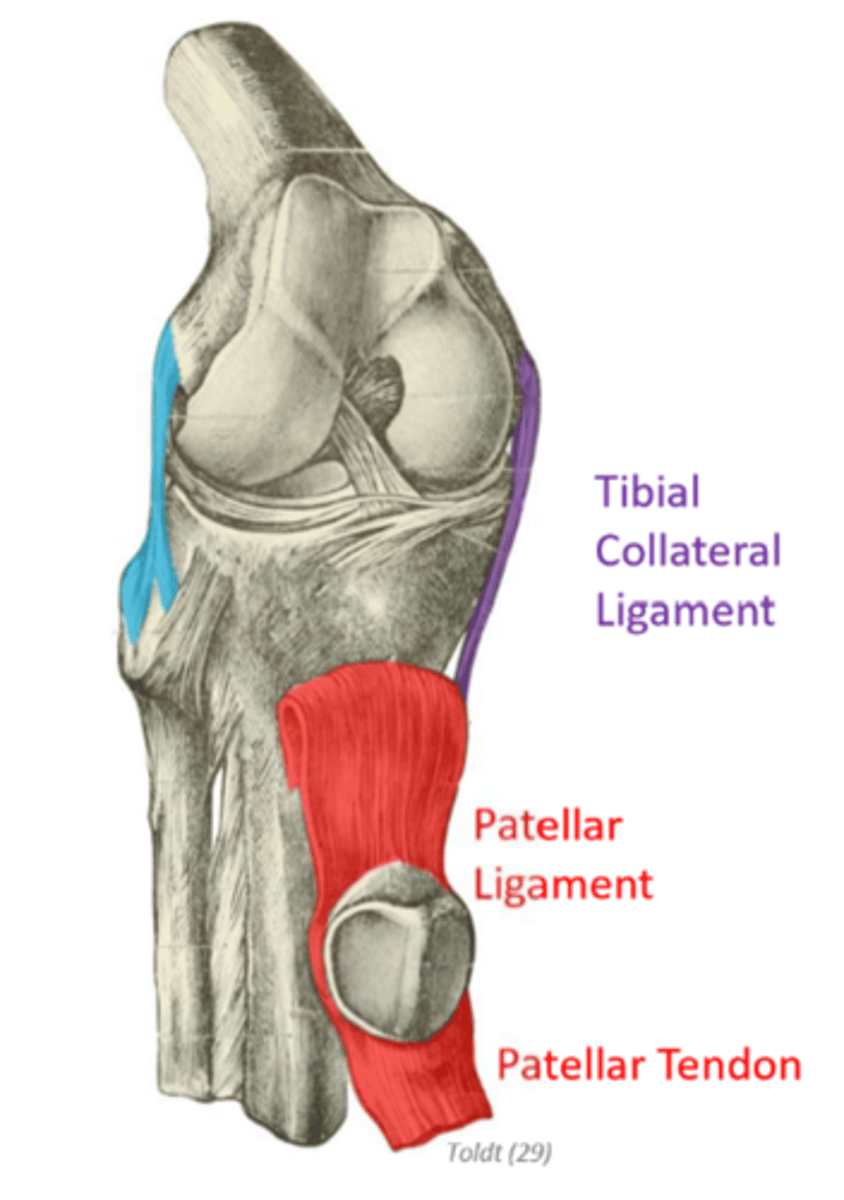
What is the fibular (lateral) collateral ligament (LCL) and what is its function?
LCL connects the lateral femur to the fibular head
- resists varus stresses , forces pushing the knee outwards
- stabilizes the lateral side of the knee
- less commonly injured
How can leg symptoms help identify a possible pulmonary embolism?
often arises from a deep vein thrombosis , seen in the leg
- it will present will leg pain or tenderness, swelling and even warmth and redness over the area of skin
- swelling is usually seen in the calf or thigh
What muscles are cut during a mediolateral episiotomy?
bulbospongiosus and transverse perineal muscles
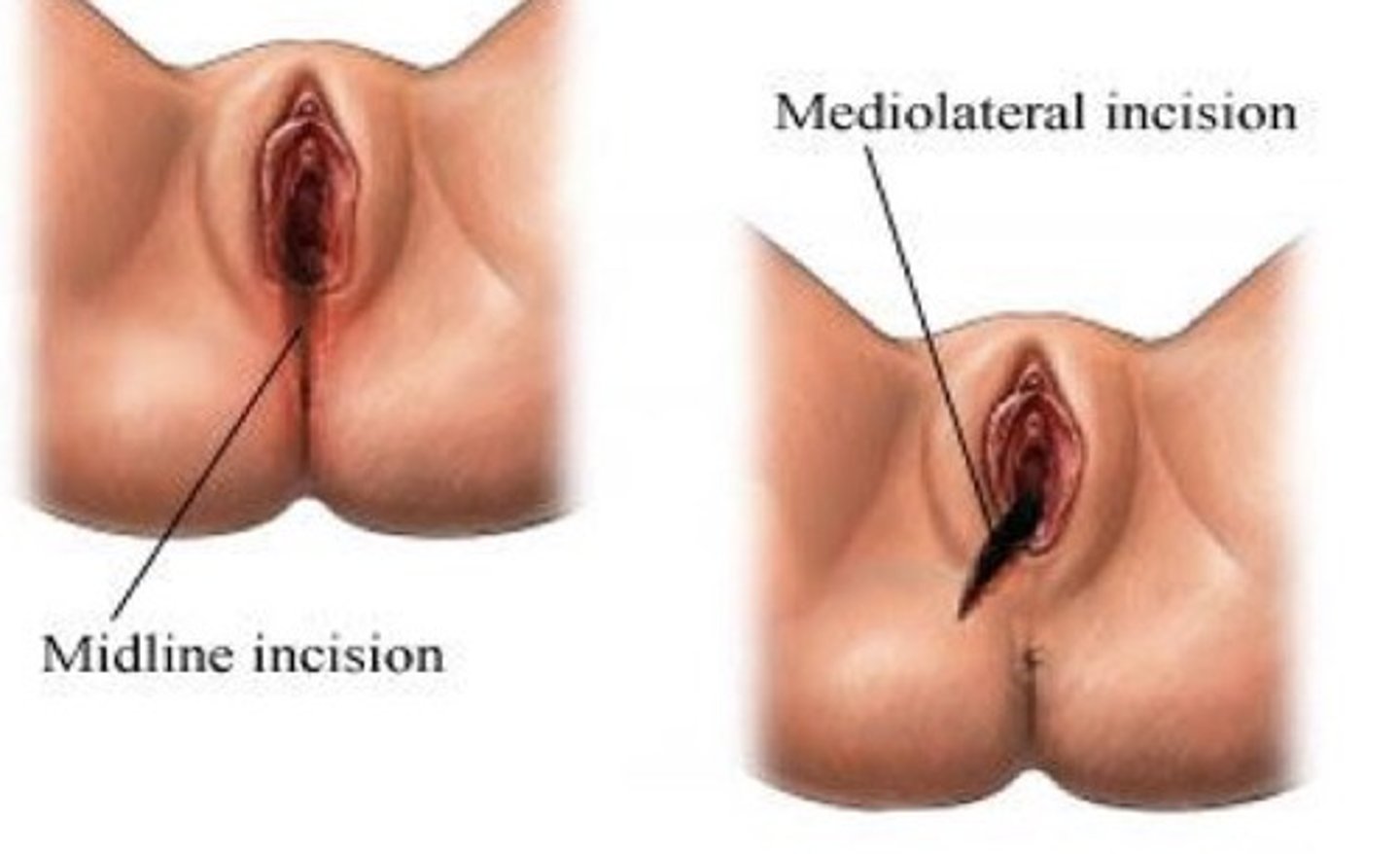
What is pelvic organ prolapse and what are its common causes and symptoms?
descent of pelvic organs such as the (uterus, bladder, rectum) through the vaginal canal due to weakening of pelvic floor muscles and ligaments
- typically caused by childbirth, aging, chronic increased intra-abdominal pressure (constipation, obesity)
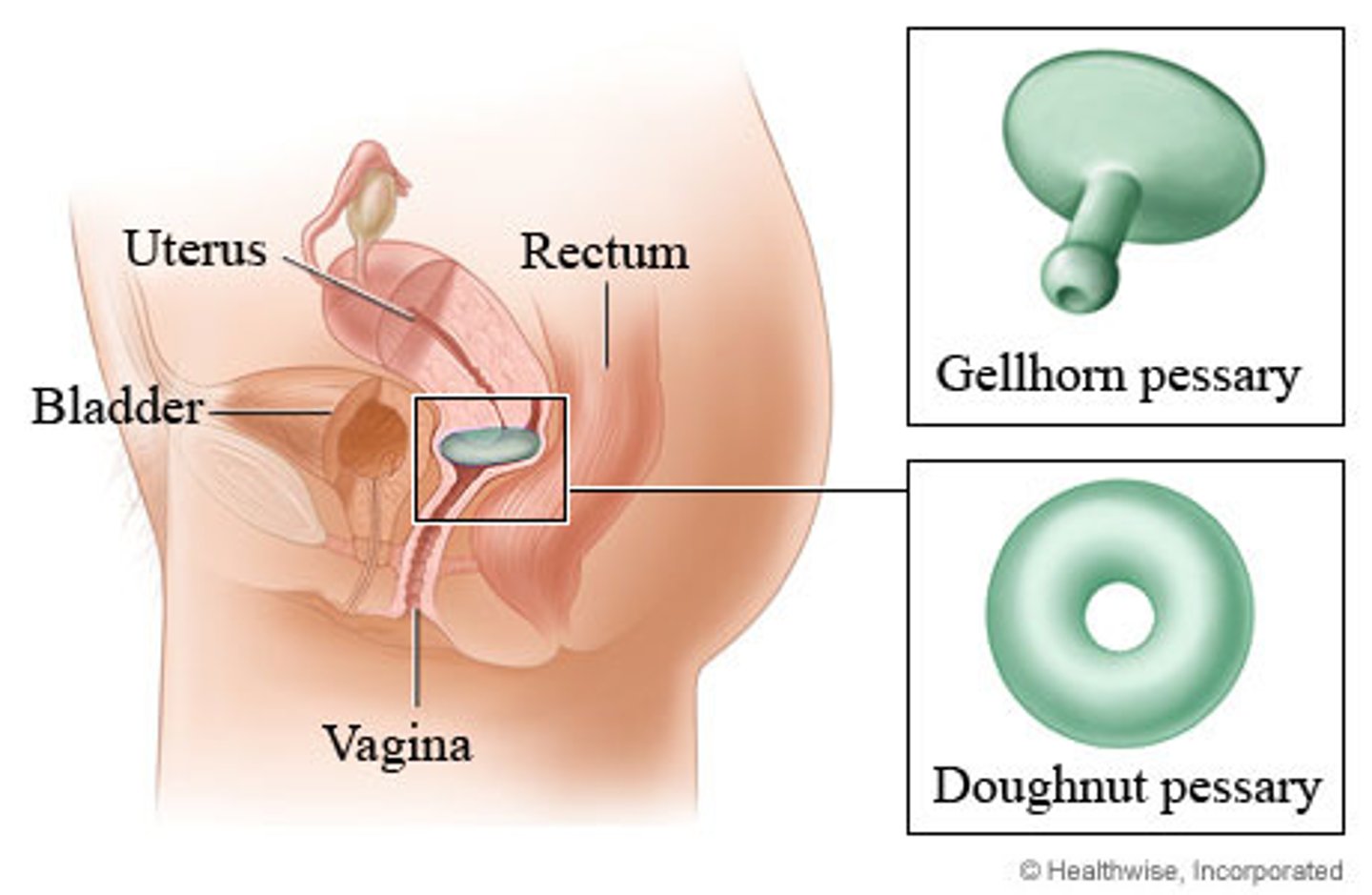
What is a rupture of the urethra, and how do anterior and posterior urethral ruptures differ?
urethral rupture refers to a complete tear of the urethra, often due to trauma
- anterior is seen with straddle injury
- posterior is caused by a pelvic fracture showing signs of urine leaks into retropubic space on urethrogram
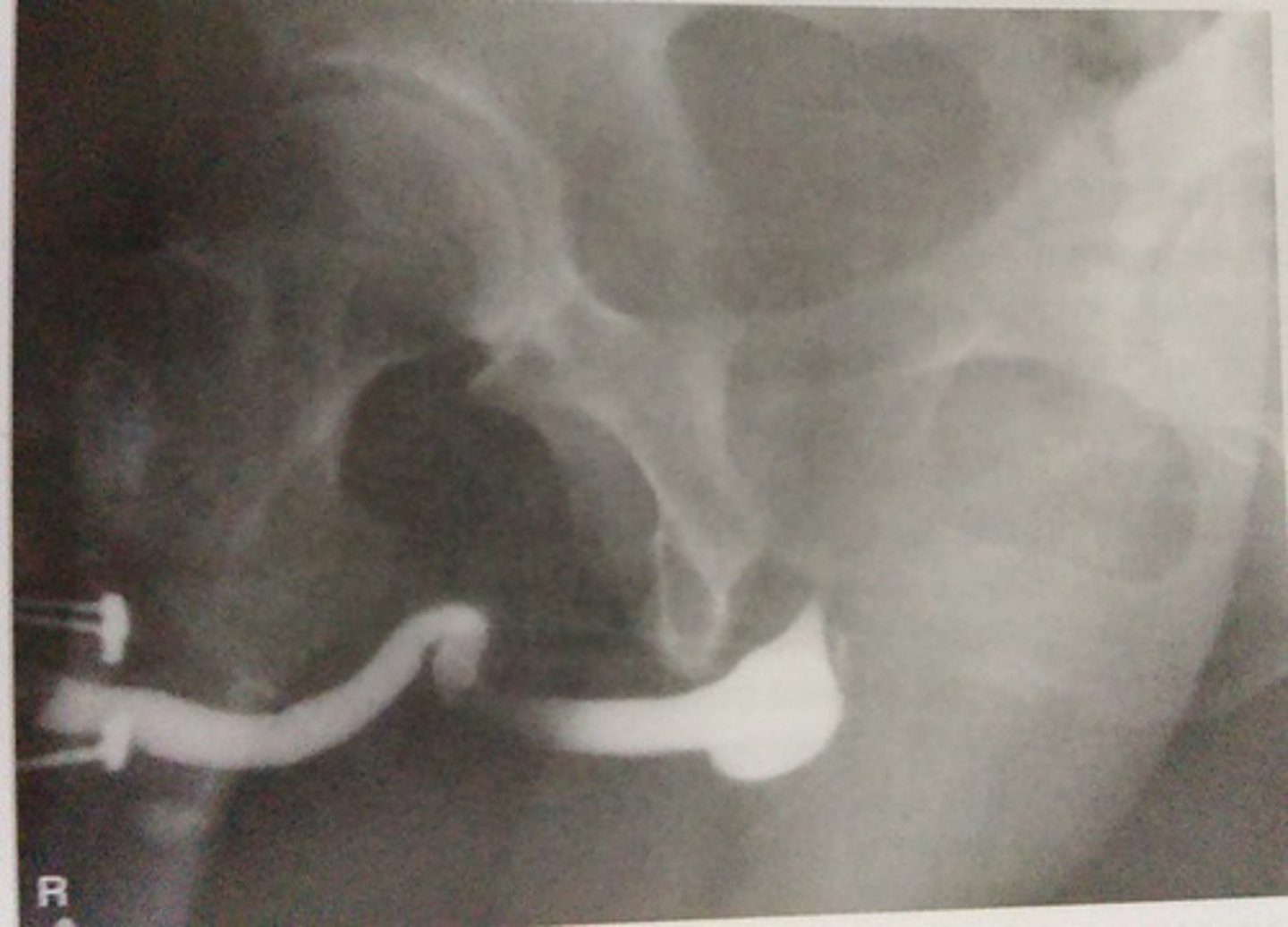
What is the Kendall/Thomas Test and what does it assess?
test for tight iliopsoas muscle
- when affected leg is pulled towards chest it causes superior pelvic tilt
- the test will have the patient pulled there leg to there chest and test the opposite leg
- tight iliopsoas and rectus femoris can be differed from movements made at the knee
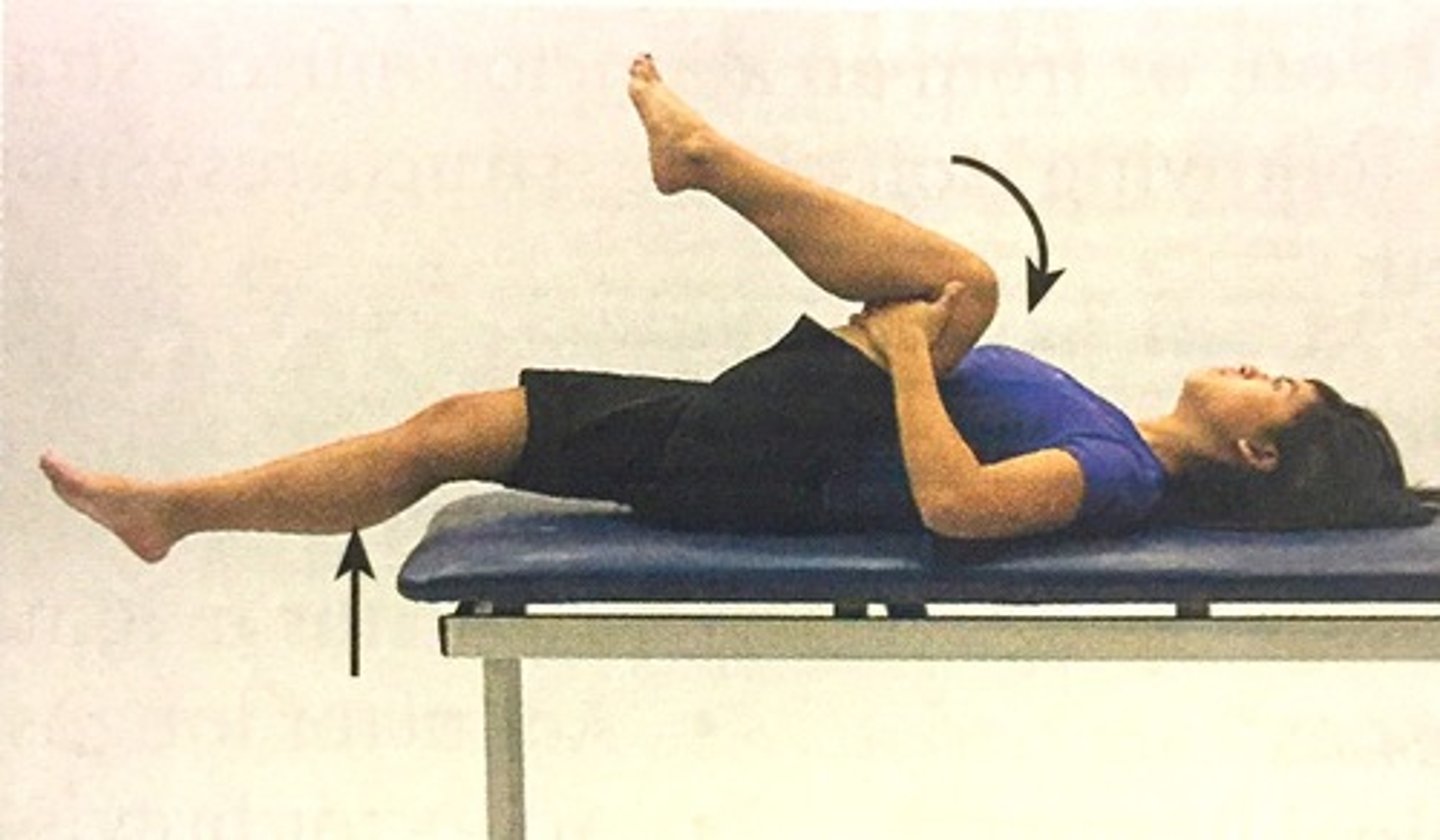
What clinical signs are typically seen with a hip fracture?
shortened leg length on affected side
externally rotated hip